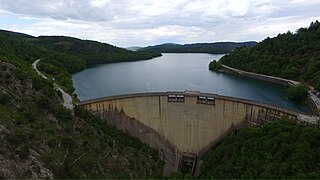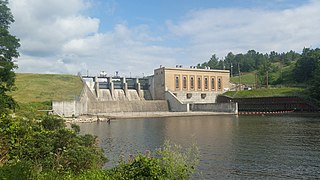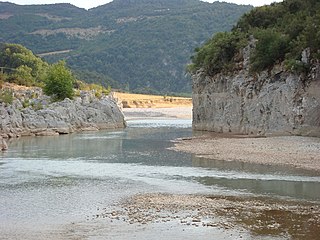
Hydroelectricity is electricity produced from hydropower. In 2015, hydropower generated 16.6% of the world's total electricity and 70% of all renewable electricity, and was expected to increase about 3.1% each year for the next 25 years.

The Plastiras Dam is a concrete arch dam in Karditsa regional unit, Greece that impounds the Tavropos (Megdovas) River, creating an artificial lake respectively called the Lake Plastiras.

The Bastyan Power Station is a conventional hydroelectric power station located in Western Tasmania, Australia.

The Mackintosh Power Station is a conventional hydroelectric power station located in Western Tasmania, Australia.

The Reece Power Station is a conventional hydroelectric power station located in the West Coast region of Tasmania, Australia.

Tippy Dam or Tippy Hydro was built 1918 and is a hydroelectric dam operated by Consumers Energy. The original name of the dam was Junction Hydro, but it was renamed to honor a Consumers board of directors member, Charles W. Tippy. The dam spans the Manistee River about 170 miles from its headwaters which include Manistee Lake, on the river's way to Lake Michigan.
Energy markets are commodity markets that deal specifically with the trade and supply of energy. Energy market may refer to an electricity market, but can also refer to other sources of energy. Typically energy development is the result of a government creating an energy policy that encourages the development of an energy industry in a competitive manner.

The Seyhan Dam is a hydroelectric dam on the Seyhan River north of Adana, Turkey

The Fierza Hydroelectric Power Station is a large hydroelectric power station on the Drin River, in Albania.

The Murum Dam is a gravity dam on the Murum River in Sarawak, Malaysia. Construction began in 2008. The dam's reservoir began to fill in July 2013 and the first generator was commissioned in December 2014. The fourth and final turbine began operations on 8 June 2015. Concerns have been raised about the displacement of the Dayak people and the removal of rainforest due to the construction of the dam.

Alpaslan-1 Dam is a dam and hydroelectric power station in Muş Province, Turkey. The foundation stone for the dam was laid in 1994 and construction on the dam superstructure began in 1998. The dam began to impound its reservoir in 2008 and the first of four 40 MW generators was operational in 2009. The second was commissioned in 2012.
Tortum Dam is a dam on the Tortum River in Erzurum Province, Turkey. The development, backed by the Turkish State Hydraulic Works, was built on a natural landslide near Tortum Waterfall and raises the level of the existing lake for hydroelectric power production.

Stave Falls Dam is a dual-dam power complex on the Stave River in Stave Falls, British Columbia, Canada. The dam was completed in 1912 for the primary purpose of hydroelectric power production. To increase the capacity of Stave Lake, the dam was raised in 1925 and the Blind Slough Dam constructed in an adjacent watercourse 500 m (1,600 ft) to the north, which was the site of the eponymous Stave Falls. In 2000, the dam's powerhouse was replaced after a four-year upgrade. The powerhouse was once British Columbia's largest hydroelectric power source and is a National Historic Site of Canada.

The Kremasta Dam is an earth-fill embankment dam on the Achelous River in Aetolia-Acarnania, Greece. It is located just downstream of where the Agrafiotis, Tavropos and Trikeriotis rivers meet to form the Achelous. The dam was constructed between 1961 and 1965 and its four 109.3 MW Francis turbine-generators were commissioned between 1966 and 1967. Shortly after the dam's reservoir, Lake Kremasta, was filled a 6.3-Mw earthquake occurred. This has been attributed to reservoir-induced seismicity. Lake Kremasta is the largest artificial lake in Greece.

Wyman Dam is a hydroelectric dam in Somerset County, Maine.

The Mesochora Dam is concrete-face rock-fill dam on the Acheloos River near Mesochora in Trikala, Greece. The 150 m (490 ft) tall dam is part of the Acheloos River Diversion which is intended to divert a portion of the Acheloos west to irrigate 240,000–380,000 ha in the Thessaly plains. The project includes the Mesochora, Sykia, Mouzaki and Pyli Dams along with a 17.4 km (10.8 mi) long channel.

The Kastraki Dam is an earth-fill embankment dam on the Achelous River near the village of Kastraki in Aitoloakarnania, Greece. It was completed in 1969 for the purposes of hydroelectric power generator, flood control and irrigation. The dam's power station houses four 80 MW Francis turbine-generators for an installed capacity of 320 MW. In 2010 the dam's overflow chute spillway was upgraded with 20 fuse plugs which increased the maximum height of the reservoir by 1.93 m (6.3 ft) and its storage capacity by 44,000,000 m3 (36,000 acre⋅ft).

The Güllübağ Dam is a gravity dam near the town of Güllübağ on the Çoruh River in Erzurum Province, Turkey. The primary purpose of the dam is hydroelectric power production. Construction on the river diversion tunnel began in 2009 and the dam was complete in 2012. That same year the first generator became operational and the final generator was operational in March 2013. Water from the dam is sent down downstream through a 3,200 m (10,500 ft) long penstock where it reaches an 84 MW power station. The dam is part of the Çoruh Development Plan and it is owned by Turkey's State Hydraulic Works.

The Tatar Dam is a earth-fill dam on the Peri River, near the village of Tatarköy in Kovancılar district of Elazığ Province, Turkey. Its primary purpose is hydroelectric power generation and is the sixth and last dam in the Peri River cascade, before Lake Keban. Construction on the dam began in 2008 and it began impounding its reservoir in early 2013. The power station was commissioned in late 2015. Its two generators were commissioned in February/March 2015. The 82 m (269 ft) tall dam withholds a reservoir of 299,570,000 m3 (242,870 acre⋅ft). It is owned and operated by Limak Energy and Bilgin Energy.
















